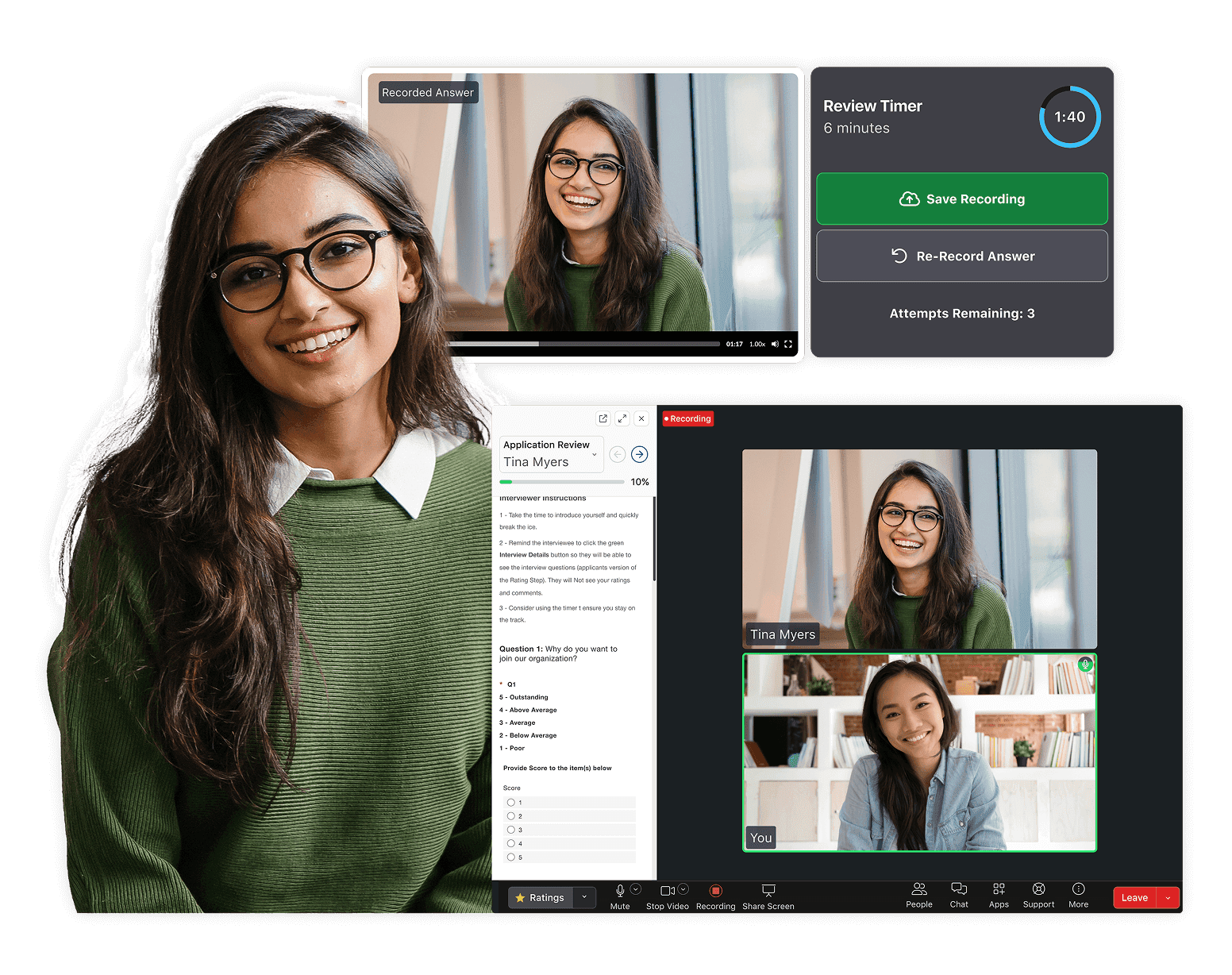
Pre-Recorded Video Interviewing Software
Conduct efficient live video interviews with built-in rating tools, AI transcripts, and a branded, mobile-friendly platform designed specifically for your recruiting needs.
Written by
VidCruiter Editorial TeamReviewed by
VidCruiter Editorial TeamLast Modified
Sep 26, 2025
TL;DR: Live vs. One-Way Interviewing: Comparison Table
While Interviews have always been an essential step in hiring new employees, modern hiring teams now default to using remote video interviews, both live and pre-recorded. In-person interviews are still essential in many industries, but most HR teams have now standardized live and one-way video interviews as the preferred strategy. Whether conducting interviews live via conferencing software or asynchronously through one-way recorded videos, digital interview formats offer both time and cost-saving advantages for companies, especially those hiring for remote or hybrid roles.
There are several factors that influence whether your company should opt for live interviews, one-way interviews, or both, including scheduling conflicts and time zone differences between candidates and hiring teams. Because both formats have benefits and disadvantages, your HR team should carefully consider which option creates a better experience for your hiring team and the candidates you interview while also still aligning with your desired hiring needs.

A live interview is a virtual, real-time interview between candidates and hiring teams. Live interviews utilize video conferencing software that hosts the interview between companies and their interviewees. For this reason, the term is interchangeable with “live video interviews,” given that video is the most common medium for remote interviewing.

The phrase “live interview” understandably raises some questions about in-person interviews. Because interviews conducted in person are technically “live,” it may be easy to confuse them as also falling within the concept of a “live interview.” However, as far as it pertains to job interviews, the common understanding among both companies and job applicants is that a live interview will be conducted remotely over video.
That distinction is important to keep in mind as it may impact what job applicants expect when they read your job descriptions and receive instructions about your interview process. If you plan to conduct in-person interviews, opt to use that term in your communications to applicants. If you plan to use real-time remote video calls, use “live interviews” or “live video interviews.”
Video is the standard format for live interviews, although phone interviews may also fall within the definition of a live interview. It’s exceedingly common for a company’s hiring process to include a 30- to 60-minute screening interview for shortlisted candidates. Many recruiters choose to conduct this interview over the phone. This is a type of live interview that can help minimize the extra friction caused by setting up and preparing for video interviews.
However, note that even here, most applicants won’t assume that phone interviews fall within the context of a live interview. As such, be sure to be specific about whether the interview is taking place over the phone or through live video interviewing software.
Live video interviews offer several advantages to HR teams and recruiters:
Companies weighing the benefits of conducting an interview live over video should explore whether these benefits align with overall company goals.
The live interview process can have notable downsides for both candidates and companies:
These disadvantages may impact your organization’s ability to implement live interviews effectively. Notably, you may need to determine whether other interview formats work best for specific candidates or roles if these issues significantly impact your ability to interview candidates.
One-way interviews are those that involve candidates recording their answers to a list of prepared questions sent by the hiring team. Candidates then submit the recorded video to the hiring team for review. One-way interviews require candidates to have access to video recording software, including the company’s interviewing platform that provides the necessary tools to conduct a one-way interview.
Other common terms for one-way interviews include “asynchronous interviews”, “on-demand interviews,” and "automated video interviews (AVIs)", which require dedicated interviewing software. These terms can be used interchangeably in many cases, although whichever term your organization uses should be consistent across candidate communications and job postings.
One-way interviews offer several key advantages over other interview formats, including live video interviews:
One-way interviews offer a significant amount of flexibility, making them an ideal option for organizations that need a scaled approach and a faster time-to-hire.
The flexibility of one-way interviews does come with notable downsides hiring teams should consider before implementation:
Given the potential downsides, plan ahead and review best practices before implementing one-way interviews into your hiring process.

Criteria
Live Interviews
One-Way Interviews
Engagement Style
High level of engagement and interpersonal; real-time Q&A
Low engagement; no back-and-forth
Candidate Scheduling Requirements
Requires coordination between candidates and hiring teams
No scheduling required
Recruiter Availability Needed?
Yes
No
Scalability
Moderate
High
Best For
Second-round interviews, final interviews, and panel interviews; ideal for remote hiring
Early screening and large applicant pools; ideal for remote hiring
Technical Requirements
Real-time video conferencing software, stable high-speed internet connection, adequate computer processing speed, built-in or separate camera and mic
Camera, mic, and internet access
Time-to-Decision Impact
Longer, more hands-on
Faster screening turnaround
Choosing the proper format for your candidate interviews can significantly impact the quality of candidates that accept interviews, and the quality of the interviews you have with your talent pool. As you continue to develop or improve your hiring process with live and one-way interviews, consider your needs first and which interview format best fits your needs.

Consider using live video interviews if you have the following needs:
Live formats are best suited for building connections between hiring teams and candidates and gaining deeper insights into a candidate’s personality and communication style.
Consider using one-way interviews if you have the following needs:
On-demand and asynchronous interview formats are significantly less personal, but can be beneficial in many situations for both companies and job candidates. You’ll need to consider the benefits, risks, and available video recording platforms before adding one-way interviews into your hiring process.
While many interviewing platforms focus on either live interviews or one-way interviews, VidCruiter’s dynamic toolkit supports the integration of live and one-way interviews into your hiring workflow.
This flexibility empowers hiring teams to:
VidCruiter delivers a modern interviewing platform designed for a job market increasingly focused on workplace flexibility and borderless recruitment. The platform is adaptable to every type of organization, from lean recruiting teams to enterprise-level hiring operations. VidCruiter also maintains a dedicated approach that reduces bias, ensures consistency and fairness, and maintains adherence to compliance and privacy rights.
A live interview is a real-time remote interview between a job candidate and a recruiter or hiring team. Also known as live video interviews, this type of interview supports various hiring strategies that leverage recruitment across geographic locations and time zones.A live interview is a real-time remote interview between a job candidate and a recruiter or hiring team. Also known as live video interviews, this type of interview supports various hiring strategies that leverage recruitment across geographic locations and time zones.
A one-way interview is an interview where candidates record responses to prepared interview questions and then submit that video to recruiters or hiring teams. One-way interviews are ideal for early-round candidate screening to verify candidate identity and assess alignment with required knowledge and experience.
Companies now receive and interview more candidates for open jobs than in the past. The New York Times reported that applications on LinkedIn were up 45% in 2025 compared to the previous year. Many companies now use one-way interviews to help manage these larger talent pools, as well as mitigate scheduling difficulties that exist when recruiting candidates across multiple time zones.
One-way interviews work best as an initial screening tool or first-round interview, while live video interviews are effective at every interview stage. This means you can use both live and one-way interviews in a single hiring process if it helps you achieve your hiring goals.
Modernize your hiring process with expert insights and advice.